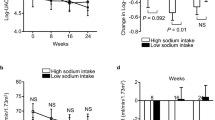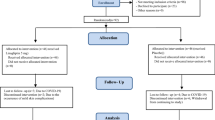Abstract
This study examines the effect of rosiglitazone on urinary albumin excretion (UAE) in patients with type II diabetes. Urinary albumin: creatinine ratio (ACR) was measured in a 52-week, open-label, cardiac safety study comparing rosiglitazone and glyburide. Patients were randomised to treatment with rosiglitazone 4 mg b.i.d. or glyburide. ACR was measured at baseline and after 28 and 52 weeks of treatment. Statistically significant reductions from baseline in ACR were observed in both treatment groups at week 28. By week 52, only the rosiglitazone group showed a significant reduction from baseline. Similar results were observed for the overall study population and for the subset of patients with baseline microalbuminuria. For patients with microalbuminuria at baseline, reductions in ACR did not correlate strongly with reductions in glycosylated haemoglobin, or fasting plasma glucose, but showed strong correlation with changes in mean 24-h systolic and diastolic blood pressure for rosiglitazone-treated patients (ΔACR vs Δmean 24-h systolic blood pressure, r=0.875; ΔACR vs Δmean 24-h diastolic blood pressure, r=0.755; P<0.05 for both). No such correlation was observed for glyburide-treated patients. In conclusion, rosiglitazone treatment was associated with a decrease in urinary albumin excretion. These findings suggest a potential beneficial effect of rosiglitazone in the treatment or prevention of renal and vascular complications of type II diabetes.
This is a preview of subscription content, access via your institution
Access options
Subscribe to this journal
Receive 12 digital issues and online access to articles
$119.00 per year
only $9.92 per issue
Buy this article
- Purchase on Springer Link
- Instant access to full article PDF
Prices may be subject to local taxes which are calculated during checkout

Similar content being viewed by others
References
American Diabetes Association. Position statement: diabetic nephropathy. Diabetes Care 2000; 23 (Suppl 1) S69–S72.
Mogensen CE . Microalbuminuria, blood pressure and diabetic renal disease: origin and development of ideas. Diabetologia 1999; 42: 263–285.
Savage S, Estacio RO, Jeffers B, Schrier RW . Urinary albumin excretion as a predictor of diabetic retinopathy, neuropathy, and cardiovascular disease in NIDDM. Diabetes Care 1996; 19: 1243–1248.
Gall MA et al. Albuminuria and poor glycemic control predict mortality in NIDDM. Diabetes 1995; 44: 1303–1309.
Neil A et al. A prospective population-based study of microalbuminuria as a predictor of mortality in NIDDM. Diabetes Care 1993; 16: 996–1003.
Whitcomb RW, Saltiel AR . Thiazolidinediones. Expert Opin Investig Drugs 1995; 4: 1299–1309.
Mishra SK, Aaronson PI . A role for a glibenclamide-sensitive, relatively ATP-insensitive K+ current in regulating membrane potential and current in rat aorta. Cardiovasc Res 1999; 44: 429–435.
Knock GA, Mishra SK, Aaronson PI . Differential effects of insulin-sensitizers troglitazone and rosiglitazone on ion currents in rat vascular myocytes. Eur J Pharmacol 1999; 368: 103–109.
Law RE et al. Expression and function of PPARgamma in rat and human vascular smooth muscle cells. Circulation 2000; 101: 1311–1318.
Goetze S et al. PPARgamma ligands inhibit migration mediated by multiple chemoattractants in vascular smooth muscle cells. J Cardiovasc Pharmacol 1999; 33: 798–806.
Xin X, Yang S, Kowalski J, Gerritsen ME . Peroxisome proliferator-activated receptor gamma ligands are potent inhibitors of angiogenesis in vitro and in vivo. J Biol Chem 1999; 274: 9116–9121.
Kruszynska YT, Yu JG, Olefsky JM, Sobel BE . Effects of troglitazone on blood concentrations of plasminogen activator inhibitor 1 in patients with type 2 diabetes and in lean and obese normal subjects. Diabetes 2000; 49: 633–639.
Kato K et al. Improvement by the insulin-sensitizing agent, troglitazone, of abnormal fibrinolysis in type 2 diabetes mellitus. Metabolism 2000; 49: 662–665.
Haffner FM, Greenberg AS, Weston WM, Chen H, Williams K, Freed MI . Effect of rosiglitazone treatment on non traditional markers of cardiovascular disease in patients with type II diabetes mellitus. Circulation 2002; 106: 679–684.
Lebovitz HE et al. Rosiglitazone monotherapy is effective in patients with type 2 diabetes. J Clin Endocrinol Metab 2001; 86: 280–288.
St John Sutton M, Rendell M . for the Rosiglitazone clinical trials study group. A comparison of the effects of rosiglitazone and glyburide on cardiovascular function and glycaemic control in patients with type II diabetes mellitus. Diabetes Care, in press.
Wan Nazaimoon WM et al. Systolic hypertension and duration of diabetes mellitus are important determinants of retinopathy and microalbuminuria in young diabetics. Diabetes Res Clin Pract 1999; 46: 213–221.
Stehouwer CD, Lambert J, Donker AJ, van Hinsbergh VW . Endothelial dysfunction and pathogenesis of diabetic angiopathy. Cardiovasc Res 1997; 34: 55–68.
UK Prospective Diabetes Study (UKPDS) Group. Intensive blood-glucose control with sulphonylureas or insulin compared with conventional treatment and risk of complications in patients with type 2 diabetes (UKPDS 33). Lancet 1998; 352: 837–853.
UK Prospective Diabetes Study (UKPDS) Group. Effect of intensive blood-glucose control with metformin on complications in overweight patients with type 2 diabetes (UKPDS 34). Lancet 1998; 352: 854–865.
UK Prospective Diabetes Study Group. Tight blood pressure control and risk of macrovascular and microvascular complications in type 2 diabetes: UKPDS 38. BMJ 1998; 317: 703–713.
Levin SR et al. Effect of intensive glycemic control on microalbuminuria in type 2 diabetes. Veterans Affairs Cooperative Study on glycemic control and complications in type II diabetes feasibility trial investigators. Diabetes Care 2000; 23: 1478–1485.
Eibl N, Schnack C, Frank M, Schernthaner G . Initial urinary albumin excretion determines the progression of microalbuminuria in patients with type-2 diabetes and normotensive blood pressure values despite improved metabolic control. Diabetes Res Clin Pract 1998; 39: 39–45.
Mogensen CE et al. Prevention of diabetic renal disease with special reference to microalbuminuria. Lancet 1995; 346: 1080–1084.
Ravid M, Lang R, Rachmani R, Lishner M . Long-term renoprotective effect of angiotensin-converting enzyme inhibition in non-insulin-dependent diabetes mellitus. 7-year follow-up study. Arch Intern Med 1996; 156: 286–289.
Buckingham RE et al. Peroxisome proliferator-activated receptor-gamma agonist, rosiglitazone, protects against nephropathy and pancreatic islet abnormalities in Zucker fatty rats. Diabetes 1998; 47: 1326–1334.
Walker AB, Chattington PD, Buckingham RE, Williams G . The thiazolidinedione rosiglitazone (BRL-49653) lowers blood pressure and protects against impairment of endothelial function in Zucker fatty rats. Diabetes 1999; 48: 1448–1453.
Greene DA et al. A diabetes outcome progression trial (ADOPT) of long-term rosiglitazone metformin, and glyburide monotherapy in drug-naive patients. Diabetes 2000; 49 (Suppl 1) Abstract 1435.
Author information
Authors and Affiliations
Corresponding author
Rights and permissions
About this article
Cite this article
Bakris, G., Viberti, G., Weston, W. et al. Rosiglitazone reduces urinary albumin excretion in type II diabetes. J Hum Hypertens 17, 7–12 (2003). https://doi.org/10.1038/sj.jhh.1001444
Received:
Accepted:
Published:
Issue Date:
DOI: https://doi.org/10.1038/sj.jhh.1001444
Keywords
This article is cited by
-
Ferroptotic mechanisms and therapeutic targeting of iron metabolism and lipid peroxidation in the kidney
Nature Reviews Nephrology (2023)
-
Comparative Efficacy of Lobeglitazone Versus Pioglitazone on Albuminuria in Patients with Type 2 Diabetes Mellitus
Diabetes Therapy (2021)
-
Peroxisome proliferator-activated receptor activating hypoglycemic effect of Gardenia jasminoides Ellis aqueous extract and improvement of insulin sensitivity in steroid induced insulin resistant rats
BMC Complementary and Alternative Medicine (2014)
-
The role of co-morbidity in the selection of antidiabetic pharmacotherapy in type-2 diabetes
Cardiovascular Diabetology (2013)
-
Comparative effectiveness of incident oral antidiabetic drugs on kidney function
Kidney International (2012)



